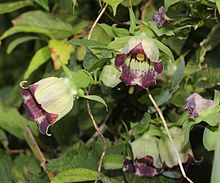Codonopsis lanceolata
| Codonopsis lanceolata | |
|---|---|

| |
| Scientific classification | |
| Kingdom: | |
| (unranked): | |
| (unranked): | |
| (unranked): | |
| Order: | |
| Family: | |
| Genus: | |
| Species: | C. lanceolata
|
| Binomial name | |
| Codonopsis lanceolata (Siebold.&Zucc.)Trautv.
| |
Codonopsis lanceolata, also called deodeok or lance asiabell,[1] is a flowering plant native to East Asia (China, Japan, Korea, and Russian Far East). It is a variety of bonnet bellflower.
Description
A hardy perennial climber that grows up to 1.5 m tall. It has bell shaped flowers that are purple inside and flowers from August to September and the seeds ripen from September to October. The flowers are hermaphrodite and are pollinated by bees and wasps.
-
Seeds
Cultivation
It grows in moist areas in woodland on low hills or mountains at an elevation of 200–1600 m. The plant likes light and medium well drained soils with plenty of moisture with a neutral to acidic ph. It likes full sun to semi-shade. The leaves and roots of the plant are edible raw or cooked. The plant has many medical uses and is used to treat lung abscesses, milk-flow obstruction and inflamed boils among many others. Slugs and snails eat young growth. The plant is propagated by seed which is surface-sown onto ericaceous compost. Division is also possible although great care must be taken as the plant hates root disturbance.
The plant is grown commercially in Hoengseong County, Gangwon Province, South Korea, where it is an important part of the local agriculture. However, many South Koreans grow a small amount in personal gardens.
Use
Culinary

Korea
The roots of Codonopsis lanceolata, or deodeok (더덕), are used in Korean cuisine. Deodeok is eaten both fresh or grilled.
Dishes
- deodeokgui – a type of gui, made by gently beating peeled and halved deodeok, then marinating the flatted deodek with the mixture of gochujang (chilli paste), gochutgaru (chilli powder), soy sauce, maesilcheong (plum syrup), honey, sesame oil, minced garlic, black pepper, and toasted sesame seeds
- deodeokjeon – a type of jeon, made by gently beating peeled and halved deodeok, coating it with mixture of glutinous rice powder and water, then pan-frying it in oil
- deodeokkimchi – a type of kimchi, made by seasoning peeled and shredded deodeok with chopped scallions, minced garlic, ginger powder, aekjeot (fermented anchovy liquid), maesilcheong (plum syrup), and water. It can be served with toasted sesame seeds sprinkled on top.
Medicinal
Codonopsis lanceolata is also used as a natural medicine.[2]
References
- ^ English Names for Korean Native Plants (PDF). Pocheon: Korea National Arboretum. 2015. p. 417. ISBN 978-89-97450-98-5. Archived from the original (PDF) on 25 May 2017. Retrieved 6 December 2016 – via Korea Forest Service.
{{cite book}}: Unknown parameter|deadurl=ignored (|url-status=suggested) (help) - ^ http://www.itmonline.org/arts/codonopsis.htm




